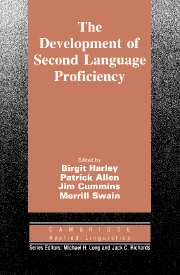Book contents
- Frontmatter
- Contents
- List of contributors
- Series editors' preface
- Acknowledgments
- Introduction
- I THE NATURE OF LANGUAGE PROFICIENCY
- II CLASSROOM TREATMENT
- III SOCIAL AND INDIVIDUAL VARIABLES
- IV PRACTICAL AND POLICY IMPLICATIONS
- Chapter 14 The complementary roles of researchers and practitioners in second language education
- Chapter 15 Educational language policies in Utopia
- V THIRTY-FIVE YEARS OF RESEARCH ON BILINGUALISM
- CONCLUSION
- References
- Author Index
- Subject Index
Chapter 14 - The complementary roles of researchers and practitioners in second language education
Published online by Cambridge University Press: 05 October 2012
- Frontmatter
- Contents
- List of contributors
- Series editors' preface
- Acknowledgments
- Introduction
- I THE NATURE OF LANGUAGE PROFICIENCY
- II CLASSROOM TREATMENT
- III SOCIAL AND INDIVIDUAL VARIABLES
- IV PRACTICAL AND POLICY IMPLICATIONS
- Chapter 14 The complementary roles of researchers and practitioners in second language education
- Chapter 15 Educational language policies in Utopia
- V THIRTY-FIVE YEARS OF RESEARCH ON BILINGUALISM
- CONCLUSION
- References
- Author Index
- Subject Index
Summary
This chapter provides an administrator's evaluation of the DBP classroom treatment studies (see Chapter 5), designed to examine the relationship between instructional practices and the development of L2 proficiency. In summary, they comprise the following:
The development and validation of the COLT observation instrument across a variety of FSL and ESL settings
The core French observation study which used the COLT instrument to describe instructional practices, then analyzed these differences in relation to L2 proficiency outcomes
The French immersion observation study which focused on vocabulary instruction, vousltu input, student talk in teacher-fronted activities and error treatment
Functional grammar instruction in French immersion which investigated the effect on L2 proficiency of providing focused input around the use of the imparfait and passé composé, as well as increased opportunities for student use of the target tenses.
Significance of the studies for practitioners
Development and validation of COLT observation scheme
Providing an accurate description of what actually takes place in a classroom is, in my view, a most worthwhile endeavor. Much of the conflicting data concerning the relative effectiveness of various approaches to second language education in North America have resulted from a lack of specificity as to what exactly is going on in the various programs (Enright 1984). In this regard, the development of the COLT observation scheme (Allen, Frohlich, and Spada 1987) is a welcome one. The categories used in the scheme provide an excellent starting point for helping teachers monitor their, and their students', behavior in the classroom.
- Type
- Chapter
- Information
- The Development of Second Language Proficiency , pp. 181 - 186Publisher: Cambridge University PressPrint publication year: 1990
- 5
- Cited by



